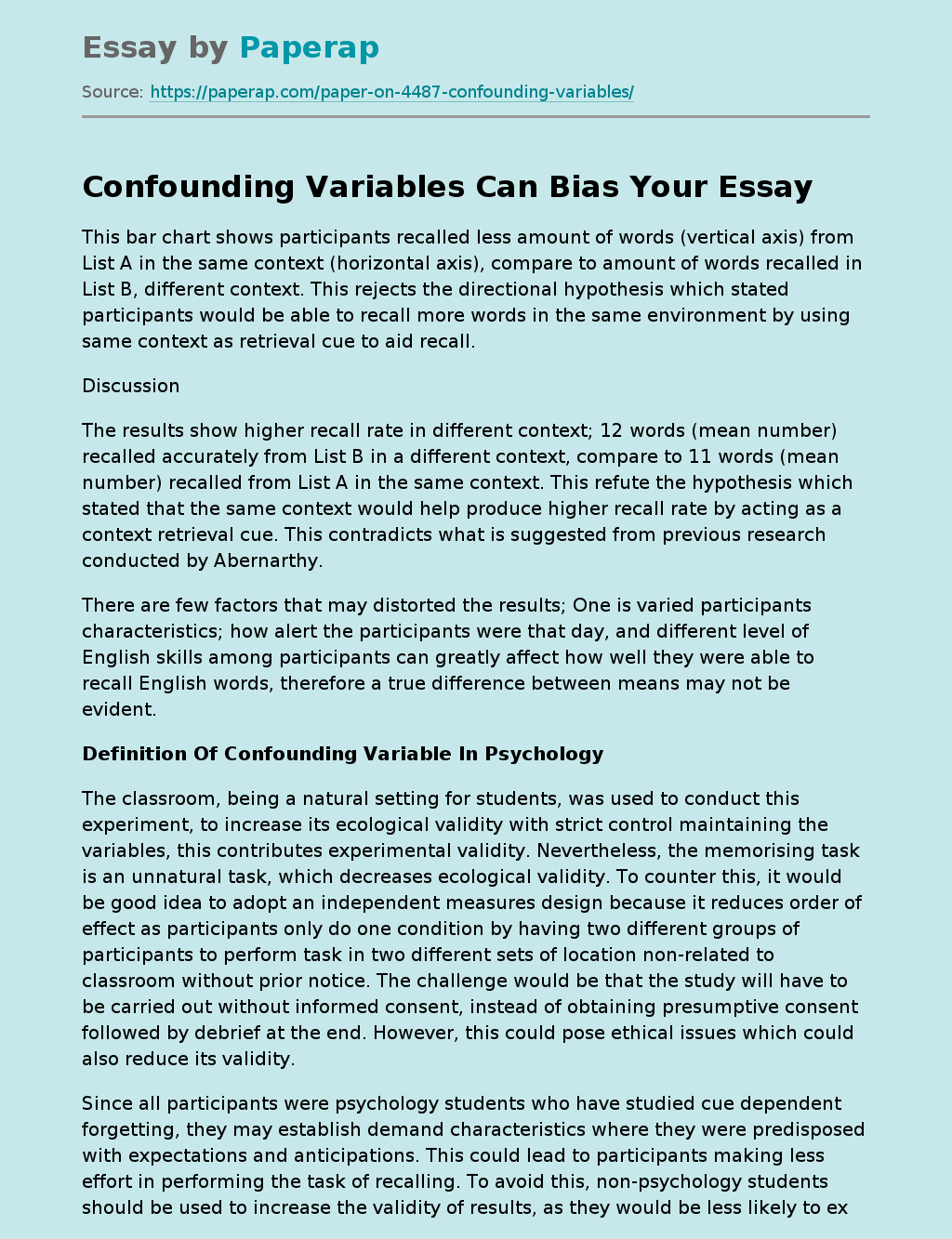Confounding Variables Can Bias Your
This bar chart shows participants recalled less amount of words (vertical axis) from List A in the same context (horizontal axis), compare to amount of words recalled in List B, different context. This rejects the directional hypothesis which stated participants would be able to recall more words in the same environment by using same context as retrieval cue to aid recall.
Discussion
The results show higher recall rate in different context; 12 words (mean number) recalled accurately from List B in a different context, compare to 11 words (mean number) recalled from List A in the same context.
This refute the hypothesis which stated that the same context would help produce higher recall rate by acting as a context retrieval cue. This contradicts what is suggested from previous research conducted by Abernarthy.
There are few factors that may distorted the results; One is varied participants characteristics; how alert the participants were that day, and different level of English skills among participants can greatly affect how well they were able to recall English words, therefore a true difference between means may not be evident.
Definition Of Confounding Variable In Psychology
The classroom, being a natural setting for students, was used to conduct this experiment, to increase its ecological validity with strict control maintaining the variables, this contributes experimental validity. Nevertheless, the memorising task is an unnatural task, which decreases ecological validity. To counter this, it would be good idea to adopt an independent measures design because it reduces order of effect as participants only do one condition by having two different groups of participants to perform task in two different sets of location non-related to classroom without prior notice.
The challenge would be that the study will have to be carried out without informed consent, instead of obtaining presumptive consent followed by debrief at the end. However, this could pose ethical issues which could also reduce its validity.
Since all participants were psychology students who have studied cue dependent forgetting, they may establish demand characteristics where they were predisposed with expectations and anticipations. This could lead to participants making less effort in performing the task of recalling. To avoid this, non-psychology students should be used to increase the validity of results, as they would be less likely to exhibit demand characteristics.
In this experiment, the null hypothesis is retained; the research concludes that there was insufficient evidence for a relationship between two variables. If the context retrieval cue of this experiment was truly ineffective, then the conclusion should deemed correct. However, in this case, experiment effectiveness is not evident due to insufficient sample size, therefore the conclusion may be erroneous, a Type II error: retaining the null hypothesis when it is not true. (Girden 2001) As the difference of magnitude and a relationship is anticipated, the difference must be detected through experimenting a large enough sample. (Girden 2001)
Due to research constraints, an insufficient number of only 8 participants are tested, therefore not enough to reveal the effect of the independent variable because it is possible that participant variables pose distortion to results. This brings the issue mentioned earlier, varied participants characteristics; the participants were not categorized with the consideration of gender or any other criteria such as intelligence, age, or English level, so to eliminate participant variables a method of matched pairs could be used, although it is comparatively more time consuming and costly.
A method of repeated measures have been used which involve repeating the experiment with the same group taking the recall test in the other place. However, this posed the problem of order effects where performance can deteriorate through the fatigue effect or improve through the practice effect. In this case, an improvement in recalling could be contributed by the practice effect expressed in List B as List B recall activity was done after List A.
The method and design used in this study is simple, straightforward and replicable. The conditions in the two contexts include some uncontrollable variables such as temperature, lighting, and noise levels that reduce the replicability of this experiment. To solve this problem, researcher should carry out this experiment in a laboratory where most confounding variables become controllable and thus increase the replicability of experiment.
The randomness of the list of words given in this experiment is another undesired confounding variable as the words have variety of characteristics among themselves, the complexity of words include being plural/singular (students seem to make more mistakes on forgetting a particular word being plural, which still counted as wrong even they remember the singular form), some words can be easily chunked due to their syllables and synonyms (aiding recall)
Evaluation:
Problems with generalising raised from using psychology students as subjects because they were predisposed with expectations and anticipations therefore are more able in recalling activity. Due to possibility of demand characteristics evident in this study and the bias in the opportunistic sampling, the results fail to provide sufficient evidence that context aids recall for the entire population. Study shows that participants do not have to be in the same context at encoding and retrieval .
Reference
Nicky Hayes (2000). Foundation of Psychology. 3rd ed. London: Thomson. p84.
Confounding Variables Can Bias Your. (2019, Dec 05). Retrieved from https://paperap.com/paper-on-4487-confounding-variables/

